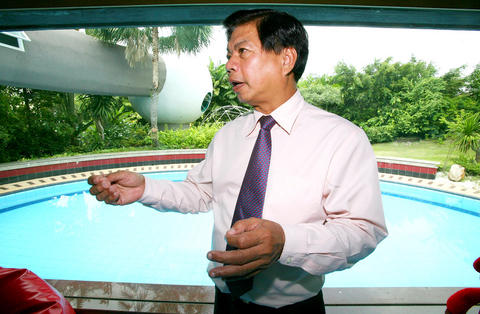Soontorn Boonyatikarn is a man of the times, throwing around terms like "eco-design" as he enthuses about the charcoal water recycling system at the Bangkok home he designed for his family two years ago.
His Bio-Solar House - designed not only to be energy efficient but to produce energy - was inspired by the humble mango tree, echoing the ideas of some of the brightest international names working in eco-architecture today.
"I threw the mango seed into the backyard. Three years later I picked up a mango," Soontorn said. "The mango tree does not need anything. The mango tree recycles everything, and it survives by the wind and the sun."

PHOTO: AFP
Unfortunately for this middle-aged professor of architecture, he is ahead of his time in Thailand, where despite abundant sunshine and a construction boom, talk of solar power and energy-efficient building design is largely rhetoric rather then reality.
But a few "green" projects are taking root.
When Soontorn built his first "eco-home" 15 years ago, everyone thought he was mad, he says. But in the past 10 years, he has designed about 200 homes, as well as a university and a handful of commercial properties.
"Now the impact is not strong, but it is getting there. With global warming, it is a sign that people have to think about the systems (they use)," he says.
Electricity for the Bio-Solar House is generated by 62.5m2 of solar paneling. They provide a surplus of energy, and every month Soontorn sells up to 1,000 baht (US$29) of electricity back to the national power grid.
All water is recycled, with the highly-insulated house also collecting dew, rain and condensation from the air conditioning.
Heat from the air conditioning warms the pool and the hot water, while the house is designed to make the most of natural light and air flow - simple measures that experts say would improve life for millions of people.
A recent report by the UN's Intergovernmental Panel on Climate Change said that eco-friendly buildings cut greenhouse gas emissions and reduce death and illness caused by poor air quality, especially in the developing world.
Some property developers are catching on to the fact that it is not just the environment that benefits but their bank balances too.
Bruno Pingel is president of Siam Best Enterprise, the firm behind Ocean 1 Tower, an eco-friendly apartment block the firms says will be the tallest building in Thailand.
He estimates that making Ocean 1 energy efficient costs just one percent of the total outlay, and says the money is quickly made back in energy savings.
The 91-floor luxury block, due to be completed by 2011 in the resort town of Pattaya, will use solar panels to power its shopping center, while the momentum of the lifts will also produce electricity.
Like Soontorn's house, the air conditioning will heat the water, and 80 percent of the water from the showers and taps will be cleaned and used to flush the toilets and fill the fountains and swimming pool.
"You have the hot water for free. You can charge the customers who live there and let them pay for the electricity they would have used for this amount of hot water, and you give them a 50 percent discount," Pingel says.
"So they are happy and you get your money back in about one or two years for the solar hot water system."
And as terms like "eco-chic" start appearing in the style sections of the world's newspapers, there is undoubtedly a certain cache in going green.
"For me, it's a selling aspect," says Pingel. "More and more people are into this issue (of global warming)."
But despite growing awareness and excited talk of an eco-building boom in Asia, Shailendra Yashwant, a climate campaigner with environmental group Greenpeace, says Thailand still has a long way to go.
"The policy makers will tell you that the potential is immense, but none of them are working on removal of barriers," he says.
"It is imperative that governments and financial institutions enforce legislation and mandatory requirements for all new buildings to incorporate and adopt 'green building' concepts," he adds.
Bangkok's Governor Apirak Kosayodhin in May announced an environmental plan for the capital, which included promoting energy-efficient buildings. But as yet, no incentives or laws for green buildings have been put forward.
Nikom Wairachpanit, director of the Bangkok Metropolitan Administration's environment department, says they will switch to energy-saving light bulbs and simply ask other government and commercial buildings to do the same.
"We don't plan for any measures to enforce them. If we do not receive any cooperation, we may consider later what should we do," he said.
"We are confident people are aware of global warming and ... will comply."
Yashwant predicts that brightly lit and inefficient buildings will dominate Bangkok's skyline for years to come, and it be some time before "eco-houses" start sprouting up like the mango trees they aim to copy.
"Soontorn's house is an experiment at best, that will be replicated by a few wealthy or alternative minded individuals," he says.

Seven hundred job applications. One interview. Marco Mascaro arrived in Taiwan last year with a PhD in engineering physics and years of experience at a European research center. He thought his Gold Card would guarantee him a foothold in Taiwan’s job market. “It’s marketed as if Taiwan really needs you,” the 33-year-old Italian says. “The reality is that companies here don’t really need us.” The Employment Gold Card was designed to fix Taiwan’s labor shortage by offering foreign professionals a combined resident visa and open work permit valid for three years. But for many, like Mascaro, the welcome mat ends at the door. A

Last week gave us the droll little comedy of People’s Republic of China’s (PRC) consul general in Osaka posting a threat on X in response to Japanese Prime Minister Sanae Takaichi saying to the Diet that a Chinese attack on Taiwan may be an “existential threat” to Japan. That would allow Japanese Self Defence Forces to respond militarily. The PRC representative then said that if a “filthy neck sticks itself in uninvited, we will cut it off without a moment’s hesitation. Are you prepared for that?” This was widely, and probably deliberately, construed as a threat to behead Takaichi, though it

Nov. 17 to Nov. 23 When Kanori Ino surveyed Taipei’s Indigenous settlements in 1896, he found a culture that was fading. Although there was still a “clear line of distinction” between the Ketagalan people and the neighboring Han settlers that had been arriving over the previous 200 years, the former had largely adopted the customs and language of the latter. “Fortunately, some elders still remember their past customs and language. But if we do not hurry and record them now, future researchers will have nothing left but to weep amid the ruins of Indigenous settlements,” he wrote in the Journal of

If China attacks, will Taiwanese be willing to fight? Analysts of certain types obsess over questions like this, especially military analysts and those with an ax to grind as to whether Taiwan is worth defending, or should be cut loose to appease Beijing. Fellow columnist Michael Turton in “Notes from Central Taiwan: Willing to fight for the homeland” (Nov. 6, page 12) provides a superb analysis of this topic, how it is used and manipulated to political ends and what the underlying data shows. The problem is that most analysis is centered around polling data, which as Turton observes, “many of these